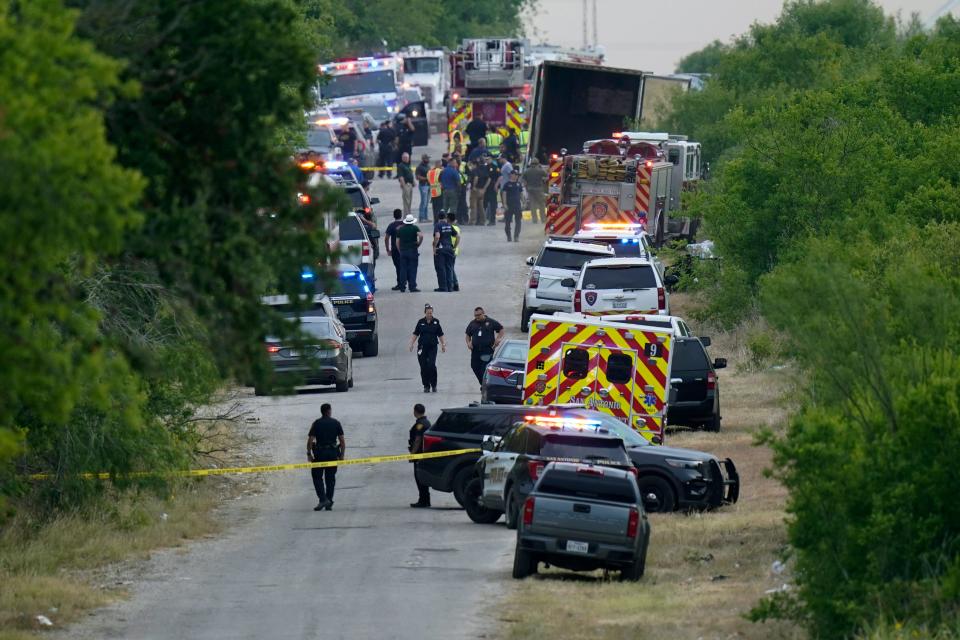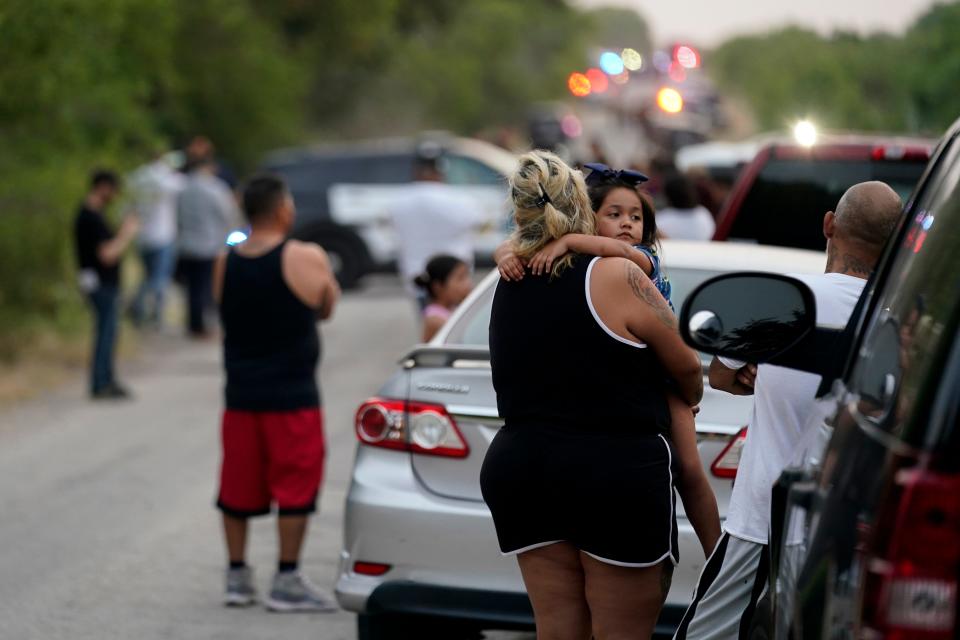53 migrants are dead in San Antonio. Identifying their remains won't be easy.
A phone number sewn into clothing. A wedding band. A new pair of tennis shoes.
These kinds of small artifacts may be crucial keys to quickly identifying the bodies of 53 unidentified migrants discovered Monday in an abandoned semi-truck in San Antonio. Experts told USA TODAY that providing final IDs on the remains may be a long, complicated and costly process, not only because multiple countries are involved, but because families of migrants seeking relocation to the United States may be fearful of coming forward.
As of Tuesday evening, Bexar County spokesman Tom Peine told USA TODAY there were 34 “potential IDs” among the victims – made up of 39 males and 12 females, including some of whom are likely teenagers. The county has already been in contact with the Mexican, Honduran, Guatemalan and El Salvadoran consulates, either because preliminary information indicated a victim might be from one of those countries or because the country reached out in concern, Peine said.
Meanwhile, a specialized team of medicolegal death investigators has been helping with the case, using whatever identification or documents may have been found on the victims or at the scene to help.
“It’s pretty much detective work,” Peine said.

While the Rio Grande Valley continues to count the highest number of unidentified deaths in Texas, counties outside of the valley and in west Texas have increasingly seen an influx in unidentified remains – and the state lacks the resources to deal with it, said Kate Spradley, a forensic anthropologist and director of Operation Identification at Texas State University. After Monday’s discovery, Spradley said her colleague received an urgent notification from a state system requesting the assistance of additional pathologists and morgue techs to help manage and respond to the newly found bodies.
A federal law, The Missing Persons and Unidentified Remains Act of 2019, was expected to help alleviate the lack of resources to address unidentified remains, especially those belonging to migrants. But Spradley said there has been no funding so far that anyone can apply for, likely due to the COVID-19 pandemic, and so the hoped for relief remains out of sight.
Part of what makes identifying migrants especially difficult is that frequently such individuals seeking entry into the United States may not want to be identified because they don’t want to be sent back to their original country, so they may carry no documents at all, or carry false documents indicating that they are, for example, from Mexico rather than Guatemala to end up closer to the border, said Lori Baker, a forensic anthropologist and professor at Texas' Baylor University who created the nation’s first database for unidentified international migrants in 2003. She spoke to USA TODAY from a dig site in the Tuscany region in Italy.

Families may also worry that raising their hands will cause them or other loved ones to end up in trouble. Peine said the best thing for worried families to do is to reach out to their consulates in those circumstances.
But he also added that “as a medical examiner, when we do these investigations we’re interested in bringing the families back together with their loved ones, and that’s the only interest we have in this case.”
Smuggling operations can involve people migrating from more than just a few countries, Baker said, noting that while several countries of origin are often raised preliminarily, such as Mexico or Honduras, “when we’re doing identifications … we have individuals coming from Africa, Asia, a lot of individuals from China, there are folks now, with everything going on, we’re seeing people coming from Eastern Europe. There’s a great deal of diversity of individuals that choose to come across the southern border and that diversity has only gotten greater over the last few years.”
Baker said people typically hide their important information on them: sewing phone numbers or wedding rings that they don’t want stolen into the lining of their clothing. Several years ago she worked with the Texas Observer to create a database called “Yo tengo nombre” or “I have a name” to showcase the items found among the unidentified remains of migrants so that family members might help identify them. That database is a smaller version of the National Missing and Unidentified Persons System, a national clearinghouse that can be searched in a similar fashion for items found with the remains of unidentified people.

Should identification not come easily off articles of clothing and other artifacts found with the victims, then the next steps are fingerprint analysis, a comparison of dental records, and a review of any missing persons reports for possible matches. Still, many migrants typically don’t have the necessary dental records on file, Baker said. If those efforts don’t pan out, then a DNA sample will likely be taken, but that could also prove difficult because databases aren’t always complete and because the U.S.’s DNA database has its own set of requirements, as do databases belonging to other nations, so it can be extremely challenging to cross-reference them if you cannot simply enter one sample into the other’s database, or vice versa, Baker said.
Still, the immense publicity around the deaths and the fact that the bodies were discovered in San Antonio means these migrants may have more of a chance of ultimately being ID’d compared with other cases, experts said. That’s because only a little over a dozen of Texas’ 254 counties have a medical examiner with requisite training; the remainder of the counties have usually elected justices of the peace – a court official – identifying remains.
“How do you have a rule of law if someone untrained determines these important details, (has) to determine if there’s foul play?” Baker said.

For unidentified bodies found, in counties without a medical examiner, those people are frequently placed in unmarked graves commingled with other remains, wrapped in garbage bags or milk crates because of a lack of space at funeral homes or refrigeration facilities, and a general lack of resources, Baker said.
“They don’t even have maps, so you can’t tell where they are buried,” Baker said, recalling a situation where an ID was made on remains but officials couldn’t remember where the person was buried.
“For humans, that process of grieving is truncated when you don’t know what happened and don’t have that person back to you,” she said. “Every mother I've spoken with where we made the identification says something along the lines of, ‘Now I have a place to pray.’”

This article originally appeared on USA TODAY: Migrants dead in San Antonio truck crash had families, lives back home

